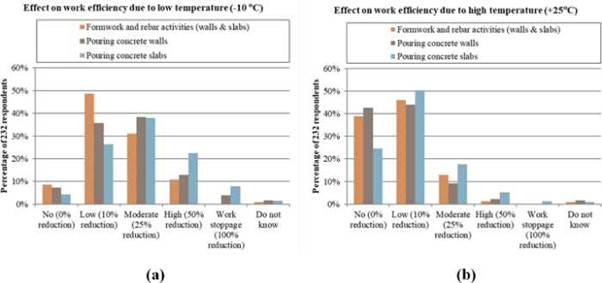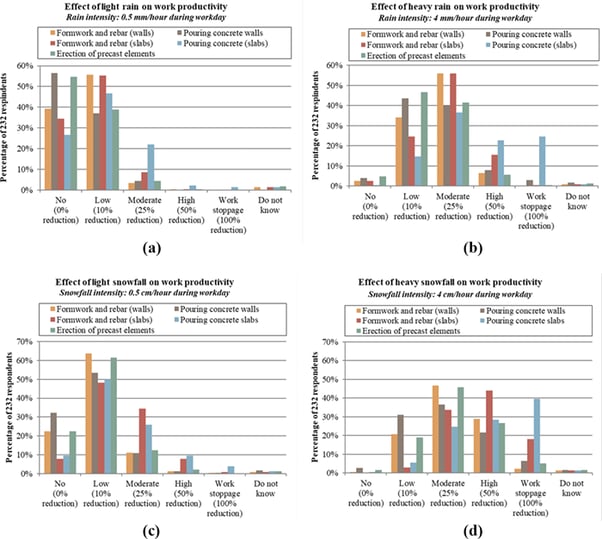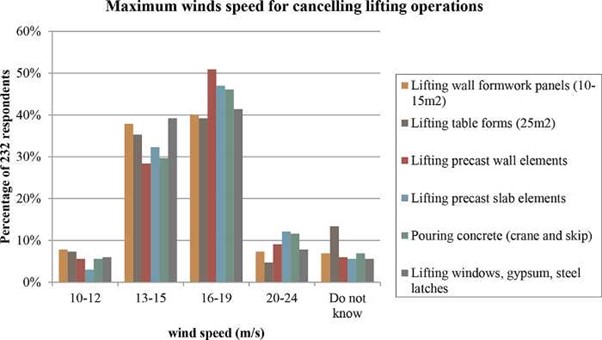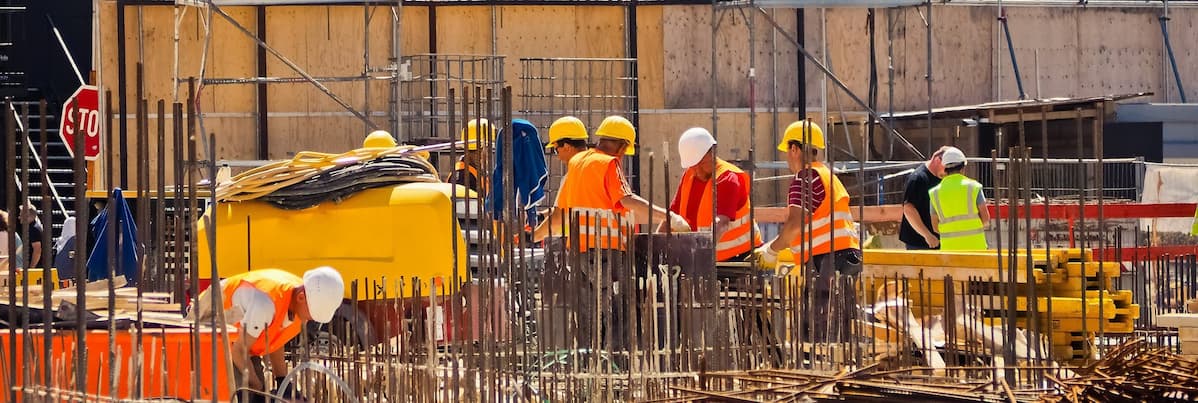Increasingly inclement weather is creating unprecedented challenges for construction. Contractors can mitigate weather-related impact on construction productivity for their projects and crews by leveraging the power of weather data, machine learning, and predictive analytics.
Let's begin by taking a look at a few examples of how adverse weather conditions impact construction productivity based on a study recently published by Emerald Publishing that surveyed 232 practitioners with long experience in concrete construction.
The Influence of temperature on construction industry labour productivity
The estimated loss of work construction labour productivity because of low temperature is shown in the figure below (diagram a).

Estimations show that approximately 80% of respondents experience a lowered productivity rate for formwork and rebar activities. It is believed that the loss in productivity for pouring concrete walls is even higher, with about 90% of respondents estimating it to be between low and high. The highest reduction was seen in those pouring concrete slabs. These results illustrate how various work types are impacted differently.
The estimated loss in productivity because of high temperature is shown in Diagram b. In general, the losses are thought to be either non-existent or low for all work tasks. However, the effect on pouring concrete slabs is somewhat higher compared with the other work tasks, but not as large of a difference as was seen with low temperatures.
How precipitation impacts work task productivity
The figure below (diagram a) shows the estimated loss in productivity for different work tasks during an 8-hour workday with a light rain intensity of 0.5 mm per hour.

Most people believe that light rain doesn't affect productivity very much, with the majority of survey respondents estimating either a 0% or 10% reduction. However, pouring concrete slabs appears to be affected more significantly, where 20% of respondents estimated a 25% decrease in productivity.
Diagram b in the figure illustrates how much productivity is lost during an 8-hour workday when it rains 4 mm per hour. Generally, more intense rain causes greater reductions in productivity compared to light rain showers, regardless of the type of work being done. According to most respondents, losses range from 10% to 25%. However, 15% say that formwork and rebar activities for concrete slabs are impacted by up to 50%, and pouring slab are even worse off—25% estimated a 100% loss due to stoppage of works.
The data suggests that construction work done on horizontal surfaces (like formwork and rebar or pouring slabs) is more delicate in comparison to tasks completed on vertical surfaces such as concrete walls when it rains heavily.
Diagram c represents the estimated loss of work task productivity due to light snowfall. Most respondents suggested a low reduction (10%) in productivity. However, more people estimated a moderate loss of productivity rather than light rain. The effects on different types of work tasks are also more evident here compared to when there is only light rain.
The data shows that respondents estimated a higher loss in productivity for work types performed on slabs, such as formwork and rebar slabs or pouring concrete slabs, compared to work tasks performed on walls.
According to the data, productivity for work tasks related to concrete walls and precast elements will decrease by 10-50% during heavy snowfall (diagram d). Additionally, formwork and rebar activities on horizontal surfaces (slabs) are expected to see a drop of 25-100%.
The Influence of wind conditions on lifting operations
The following diagram depicts the maximum wind speeds at which lifting operations are cancelled at construction projects.

The maximum wind speeds necessary to cancel a lifting operation vary significantly between types of operations, with most requiring winds 13-19 m/s. However, almost all respondents agree that any wind speed higher than 19 m/s will result in the cancellation of the lift.
When we take a closer look, we see that lifting wall formwork, table forms and frame finishing materials are more sensitive to wind than lifting precast elements and pouring concrete. For example, nearly half of respondents say that they cancel lifting operations for wall forms, table forms and frame finishing materials when the speed of the wind is higher than 15 m/s. But at the same wind speed, only 35% of respondents say they would cancel lifting operations for precast elements and pouring concrete.
Overall, respondents suggest that it is best to err on the side of caution and cancel lifting operations when wind speeds surpass 19 m/s.
How to minimise weather impact on construction productivity during extreme weather events
Clearly, the climate is causing a significant impact on productivity in the construction industry. So, what steps can we take to minimize these negative effects?
Have a weather risk management strategy
It is important to have a weather risk management strategy in place in order to avoid any potential extreme weather events and their impacts on construction projects. This strategy should identify possible weather conditions that could occur and how they would affect construction sites, as well as what mitigation measures can be put into place to prevent or minimize damage. By being prepared for extreme weather, construction companies can continue working productively even during adverse conditions.
Some specific steps that can be taken to prepare for extreme weather include stockpiling construction materials, installing temporary barriers or covers, and modifying work hours. Additionally, it is important to have a plan in place for communication and coordination between workers, as well as a way to monitor the situation so that necessary changes can be made quickly. By taking these precautions, construction companies can be ready to face any challenge the climate throws their way.
The EHAB Weather Risk Management Platform
In order to effectively mitigate extreme weather impacts and maximize construction productivity, it is important to leverage the power of technology to implement your weather risk management strategy.
The EHAB Weather Risk Management Platform provides contractors with the tools they need to manage weather risk better. With hyper-local climate-adjusted datasets, machine learning and modern planning features, the EHAB platform helps the construction industry reduce project length by up to 16% and save millions of pounds in avoided equipment cancellation fees.
In addition, the EHAB Enhanced Planner can improve your planning and workflow, helping you to minimise weather risk and deliver significant cost savings per project. To learn more about how to use Ehab to improve construction productivity, book a free 30-minute demo today.




